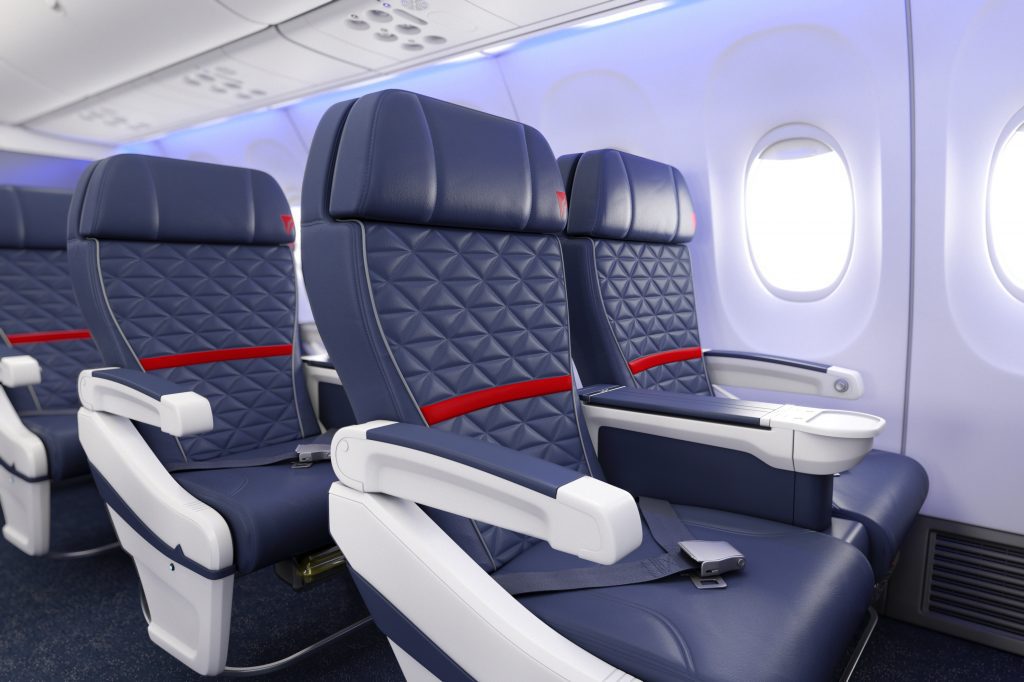Skift Take
Having seen airline fashion icons go bust, we warm to an airline smart enough to go classic.
There’s been a lot of commentary on Delta’s new re-classed cabins. Some point out that what the airline refers to as “redefining the product” consists of little more than changing dress and swapping labels. Like that’s a bad thing.
Delta went back to basics, opting for an airline’s version of the little black dress—which in its case is elegantly quilted in true-blue leather, with a vibrant red-stripe cinched waist, and chic white piping: iconic Americana.
Delta’s choice to change out covers to refresh the cabin is a proven in-service cabin strategy. While the dress Delta selected is far too aviation ‘haute-couture’ to have been cheap, it allowed Delta to introduce a new product without a massive outlay in design and completion. By eliminating big-production items, which could delay program implementation, Delta avoids having aircraft out of service longer than it would like and lessens the overall burden on the bottom line. In that regard, this selection was a safe move.
It was also risky. Competitors have made major structural changes to their cabins, and this conservative approach is not on par with some. The label change also opened Delta up to criticism with a “minus” stigma from those fearful that the introduction of “Basic Economy” unbundled fares heralds further trimming.
We patiently withheld judgment until Delta’s Investor Day, to hear the best arguments in favor of this cabin strategy the airline had to offer.
The best arguments were pretty good — especially for investors — and investors have the power to make even the most vanguard airlines tone their radical down a few notches, as they did at JetBlue.
To sum up hours: Delta’s top management argued that its strong financial performance, quality of service, and exceptional reliability have resulted in strong customer demand and reliable profitability–and will continue to do so. Delta is committed to reinvesting its profits back into the business, through continuous fleet, product, and company improvements–good news for investors and passengers alike.
Delta’s CEO, Richard Anderson, and President, Ed Sebastian, both emphasized that Delta is not interested in offering a commodity product, as the “minus” stigma would imply. Instead, the airline wants to offer a premium product, with features customers will value, and for which customers will pay a premium.
When announcing what the airline calls a “spectrum” of cabin options, Glen Hauenstein, Executive Vice President and Chief Revenue Officer for Delta, said: “Whether a customer prioritizes the perks of Delta One or the value of Basic Economy, every seat comes with impeccable service and unmatched reliability.”
That word “prioritizes” is key, and inline with the presentations made during Delta’s Investor Day today. Delta aimed for the sweet spot, between overdone and complicated cabin overhauls and the commoditised lean product of ULCC rivals.
Delta’s new “Branded Fares,” present a selection of cabins which allow “customers to tailor their travel experience.” The airline estimates that the market opportunity for its Branded Fares will be more than $1.5 billion per year by 2018.
The airline’s management is confident that Delta can sell these new cabin products to existing customers, and attract a greater share of the market away from competitors on both ends of the market range.
Presentations focused on the success to date of Delta’s business strategy, with operating margins running to the high end of its projections for 2014 at around 13%, a 20% return on invested capital, $6 billion annual operating cashflow and more than $3 billion free cash flow. Delta committed to maintaining investor confidence, improving its PE ratio, keeping profits high, and reinvesting 50% of profits back into the airline–with a sound strategy that will yield returns to investors and continuous improvements to the overall passenger experience.
No matter how you dress it up, the aircraft interiors race depends as much on drive as stamina. Oh, yeah, and money. Lots and lots of money.
By going back to basics, focusing on sound business principles, and meeting customer expectations—without excess—Delta has left itself plenty of room for bigger changes to the cabin if the season calls for it. It also kept its bottom line a flattering black, attractive to investors who ultimately finance the “big makeovers.”
The Daily Newsletter
Our daily coverage of the global travel industry. Written by editors and analysts from across Skift’s brands.
Have a confidential tip for Skift? Get in touch
Tags: delta air lines, earnings, in-flight
Photo credit: Delta's rebranded and cleaned up Delta One seats. Delta Air Lines
